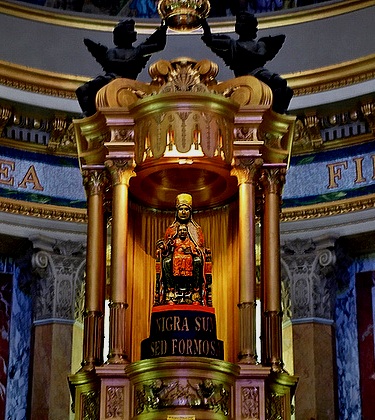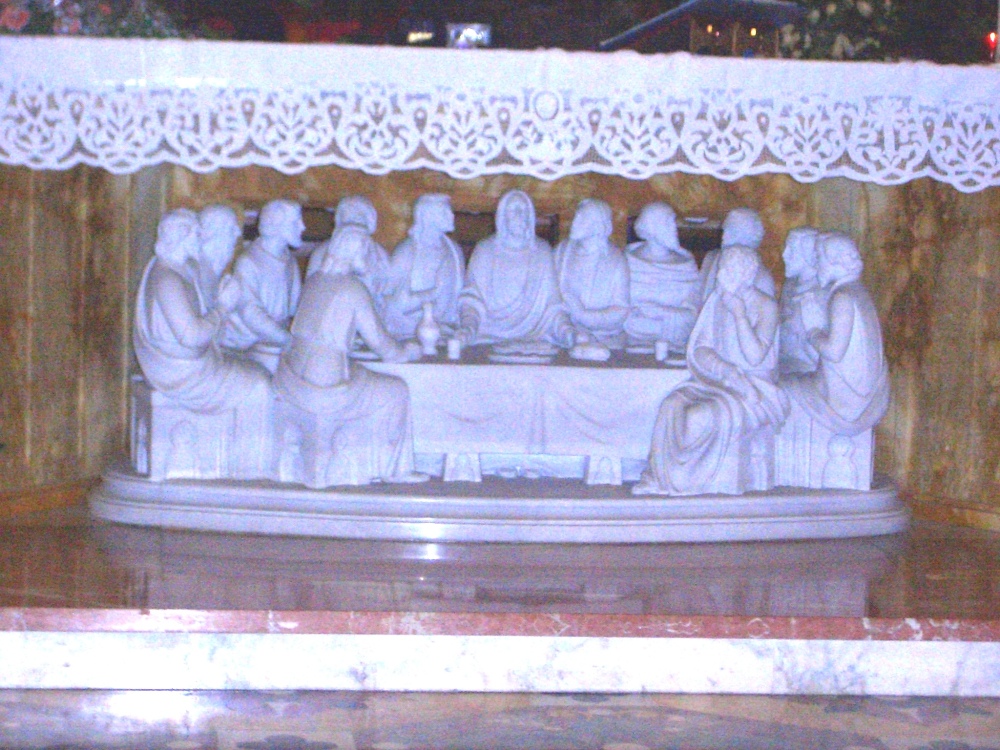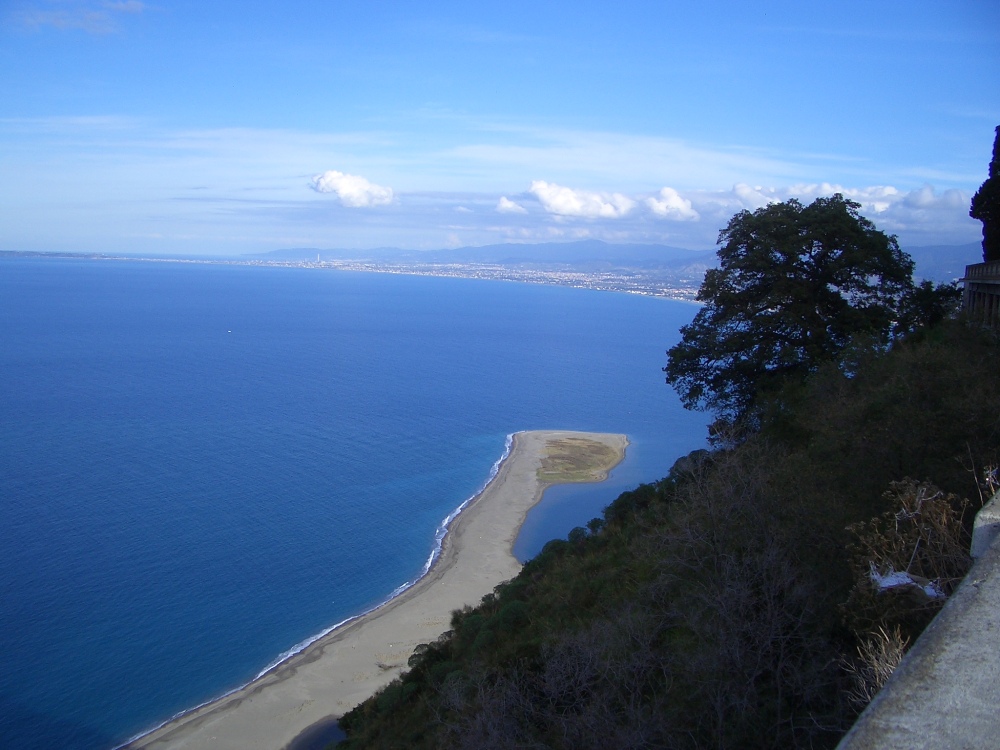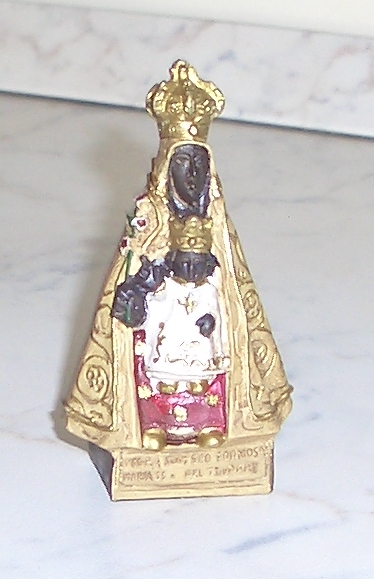Yesterday we went to Tindari in Eastern Sicily, famous for its statue of a black Madonna with a black baby Jesus.

Like most of the “black Madonna” statues from places where the majority of the population is white, she is carved out of wood, and so was originally light-skinned. Wood darkens over time so, eventually, she became black. This transformation meant she was not just another Madonna statue but, rather, something rare, precious and the product of a miracle; and so pilgrims visited her from far and wide. Among them, in 1995, was Pope John Paul II.

She dates from around 800 AD, according to a guide book I sneakily read beside a souvenir stand without actually buying it. We’re on an economy drive at the moment, as my husband reminds me every time I go within 50 feet of any establishment that sells anything whatsoever. It took me a while to figure out why he always offers to hold my handbag when I go to the toilet. He’s worried I’ll get distracted on the way.
She is carved from a rare type of cedar wood which comes from Turkey and the Middle East, according to the guide book I don’t have, and was brought to Sicily by sailors in the Byzantine era. Legend has it that the ship upon which she was being transported – where to, nobody knows – was driven into the bay of Tindari by a ferocious storm. The sailors dumped most of the cargo on the beach to make the ship more manoeuvrable, and set out again. Another storm blew up, more violent than the previous one, and drove them back onto the beach once more. They deposited the statue as well, the last thing they had on board, and set sail with their fingers crossed. This time they got away safely and floated off into the sunset.
Meanwhile the small number of Sicilian bumpkins who eked out a living in the remains of the once grand city of Tyndaris, founded by the Ancient Greeks, were most excited by what they found on their gorgeous strip of beach. She was already a centuries old antique, from a far off land, and she was black skinned with a black baby; yet she was clearly the Madonna with baby Jesus.

The locals took her up to their tiny church on the top of the peak overlooking the bay of Tindari, and there they prayed to her. News spread of the miraculous way she had come to Tindari, and of her remarkable black skin, and pilgrims began arriving from distant places.
The Mediterranean was plagued by pirates in those days, and a gang of Algerian desperadoes under the command of a ruthless leader called Rais Dragut (or Turgut Reis) destroyed the original church in 1544, so a new one was built as soon as possible.
This bit of history made sense of a strange tourist souvenir on sale on the walk up to the sanctuary – a collection of pirates’ heads carved out of coconut shells, complete with bandanas and earrings. They were nestled among a forest of black plastic madonnas in various sizes, ranging from the 2 Euro pocket size all the way up to 30 Euro whoppers, beside mountains of rosary beads, and just in front of various black Madonna bumper stickers saying “My driver went all the way to the sanctuary of Tindari and all he bought me was this Black Madonna bumper sticker,” or something along those lines: I couldn’t read them properly as my husband was nervously pulling me away.

Our Lady of Tindari now stands in a completely modern church, finished in 1979. It is decorated with mosaics and stained glass windows in fairly traditional style, yet the modern touches are obvious in all the details and, to me, this gives it rather a Disneyland feel. It is beautiful nevertheless, particularly the exterior.
The Madonna statue is displayed up on high above the altar, and beneath her is a Bible quotation in Latin, from the Song of Songs: “Nigra sum sed Formosa” – I am black but I am beautiful. I found a very interesting analysis of this book of the bible in a blog by a Brazilian priest and biblical scholar.




From the piazza in front of the church you can see marvellous views over the bay. When the sea level is low, the beach forms a strange shape which looks like the black Madonna and her child viewed side-on. Story has it that a pilgrim in early Medieval times, who had a small baby, refused to pray to the Madonna because she was black. When she left the church she slipped and dropped her baby, who slid right down to the beach but was saved from drowning by the strange strip of sand which rose up to save him, and the miracle restored her faith so she went back to the church to pray to the Madonna in thanks.

As we left the sanctuary I think my husband gave up a silent prayer of thanks that we had gone all round the sanctuary and the only money I spent was three euros on a little black Madonna as a gift for my mother in law, aka The Godmother.

Reblogged this on RD Revilo.
LikeLike
what a beautiful day 🙂 thanks for sharing such a wonderful experience with us!
LikeLike
Love your blog! I look forward to reading everything you write and I so appreciate your writing style and your sense of humor. I live in Seattle and do my own blogging. I write about yoga, gardening, hiking and other outdoor activities, cultural events, as well as about my colorful Sicilian family! I am waiting for your book! I will be the first to buy it. After its publication, you will be able to buy as many trinkets, guide books, and black madonnas as your heart desires! 🙂
LikeLike
Thank you for your very nice comments!
LikeLike
So, this is the second I’m reading about the black madonnas! I recently read about the one in Montserrat, Spain. No idea it was because the wood changed color… and that this is what made it sacred.
LikeLike
I didn’t know about the wood changing colour thing either till I went to Tindari. There’s a Wikipedia article with a whole list of them, there are loads!
http://en.wikipedia.org/wiki/Black_Madonna
LikeLike
Whoa! Up to 500 in Europe alone! You would think the large number would decrease the ideas of them being sacred…
LikeLike
That’s true. It seems like a huge number, though compared to the overall number of Madonnas all over the place, I think they are a very tiny proportion of them. I wonder how many Madonna statues there are altogether in Europe? Maybe millions?
Also the black Madonnas are mostly extremely old – like the one at Tindari being from 800AD – which also makes them something really remarkable.
But I don’t know if all of them are sites of pilgrimage like Tindari: that would be interesting to know.
I found out that they actually have an annual festival in honour of the black Madonna of Tindari in New York! So I guess she’s a particularly special one 🙂
http://www.italianamericanstudies.net/ct/news/ta/send-player/me/ti/ninth-annual-festa-honor-sicilian-black-madonna-del-tindari-new-york
This web page has a photo of a guy with a picture of her tattoed on his back!!!
LikeLike
Well, the local Godfather called in Enrico to promote Tindari, see? Enrico looked around for something he could use to attract people since the few locals wouldn’t do it. “Damn! he said: I need a miracle!” He went to the old church to pray for one, though of course he didn’t believe in miracles. He did believe in the Godfather, though. And behold, he saw the statue and his miracle… The first PR man obviously had to be Italian…
LikeLike
Ha ha haaa haaaaaaaaaa! You’re bonkers! 🙂 🙂 🙂
LikeLike
Such an incredible place!
LikeLike
Hi, my friend and I are planning a trip to Sicily this September and I happened to read that the Black Madonna in Tindari has annual festival. We may be in the area around the time of the festival however I am not able to find more information or confirm that it will happen this year. Will there be a festival on Sept 7th?
Thanks, Laura
LikeLike
Hello,
They do the festival every year so there will definitely be something around that time. I’ve done a Google search but it is still too early for festival details to be online. You’ll probably be able to find something online by about July – just Google “Madonna Tindari festa 2015”
I hope you enjoy your holiday in Sicily!
LikeLike
It July 22 2019 and I just came upon this information about Madonna Tindari and I can’t believe I know nothing of this and I am a true Sicilian. Angela
LikeLike